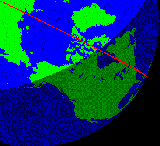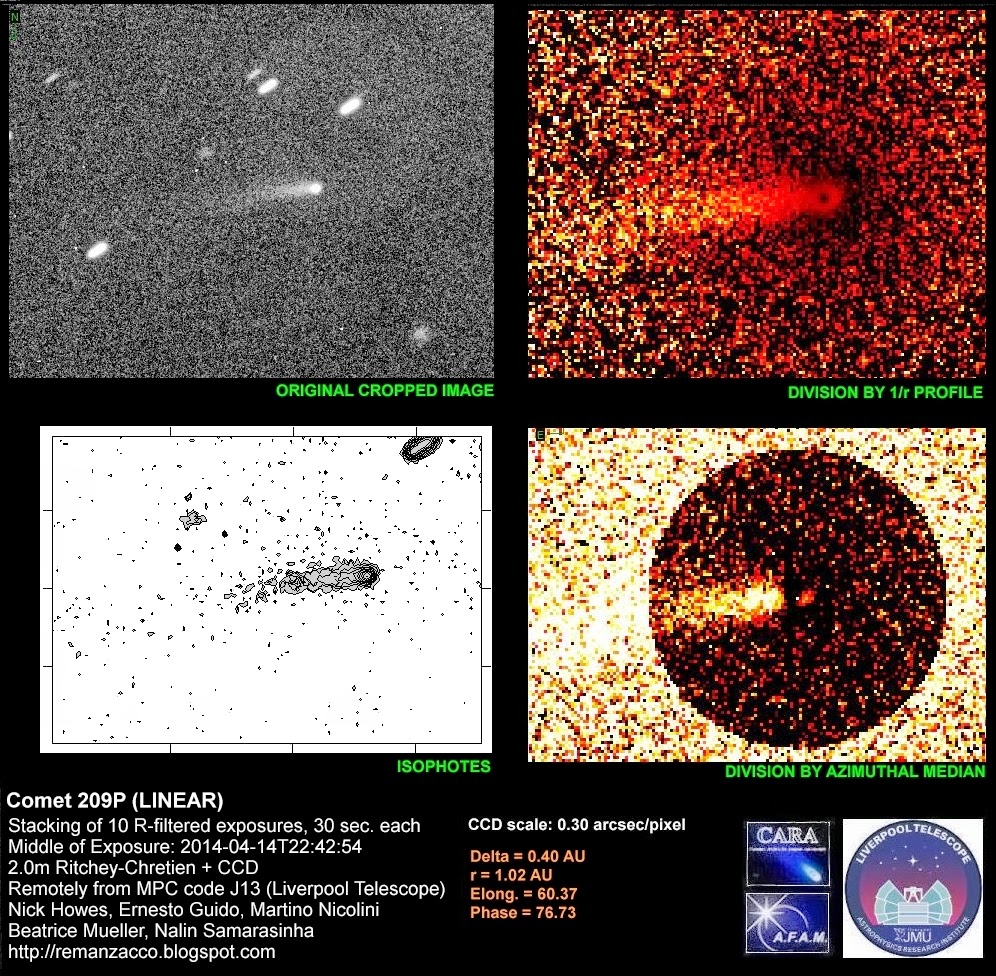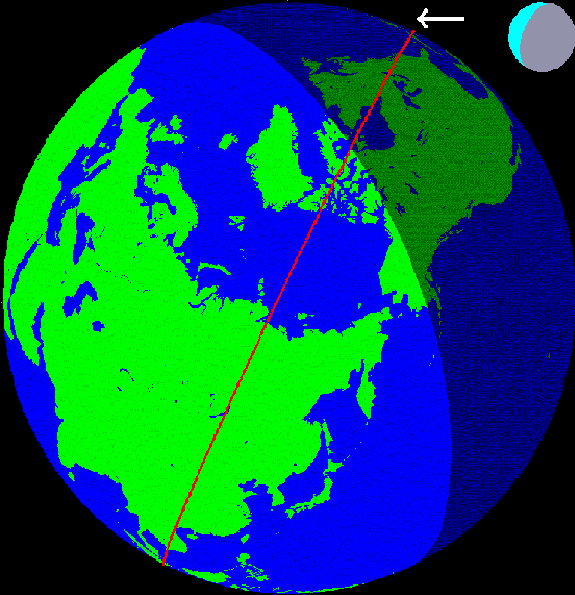It looks like you're using an Ad Blocker.
Please white-list or disable AboveTopSecret.com in your ad-blocking tool.
Thank you.
Some features of ATS will be disabled while you continue to use an ad-blocker.
14
share:
Here is another astronomical event that ATS members might want to mark in their calendars. One team of researchers had already predicted that comet
209P/LINEAR (2004 CB) was very likely to produce a meteor shower in 2014, but now Jeremie Vaubaillon of The
Institut de mecanique celeste et de calcul des ephemerides has also confirmed, using computer modelling of the comet's debris stream, that a
strong meteor shower is expected from this comet's debris.
Source: The Institut de Mecanique Celeste et de Calcul des Ephemerides (IMCCE)
Here is a graphical representation of where the debris (meteoroids) are in relation to Earth during May 2014:

Note how dense the "cloud" of meteoroids is at the point where Earth passes through them.
For comparison, here is Vaubaillon's prediction for this year's Perseid meteor shower which peaked at around 100-120 per hour according to The International Meteor Organization

Source: Jérémie Vaubaillon(IMCCE)
In the case of the meteor shower predicted for 2014, the shower will be mostly caused by the debris trail laid down by comet 209P/LINEAR (2004 CB) in 1903.
3D view of the 1903 meteoroid trail in the Solar system

Equivalent 2D view (XY).

It's at least partly because the trail of debris is relatively young that a strong shower is expected. Over time, a trail that was once densely populated with meteoroids will tend to disperse, which is what we are seeing with meteor showers like the Perseids, and the Geminids who's trails were laid down centuries ago.
Young meteoroid trails like the one we are due to pass through in 2014 are more likely to produce outbursts or even storms much like those produced by the Leonids in the past.
In 1999 for example, a dust trail produced by comet Tempel-Tuttle (the "parent body" or source of the Leonid meteor shower) in 1899 produced a storm with rates of over 3000 Leonid meteors per hour observed. The storm had been previously predicted to within 5 minutes of it's actual peak time by David Asher and Robert McNaught who pioneered the use of computer modeling to predict meteor shower peaks.
In order to answer this question, more observations of comet 209P/LINEAR (2004 CB) are needed, so I would encourage those ATS members that are capable of making observations to do so, and/or pass on this request to someone who can or other forms.
Source: The Institut de Mecanique Celeste et de Calcul des Ephemerides (IMCCE)
So there we have it. Keep in mind that there is still uncertainty as to the exact details of the encounter, but it is looking like it should exceed at least an average Perseid meteor shower year in terms of hourly rates, and possibly even reach storm level (1000 meteors visible per hour as seen under optimum observing conditions).
I'm sure we will be hearing more about this shower as predictions are refined, so stay tuned for further updates.
Related links:
The American Meteor Society
The International Meteor Organization
METEOROBS (The Meteor Observing mailing list)
Meteor Observing Calander (Meteor Showers Online)
What is the next big meteor shower? According to E. Lyytinen and P. Jenniskens, the comet 209P/LINEAR (2004 CB) will cause it in 2014. We checked is and actually confirm this prediction by running our meteor shower prediction model.
Source: The Institut de Mecanique Celeste et de Calcul des Ephemerides (IMCCE)
Here is a graphical representation of where the debris (meteoroids) are in relation to Earth during May 2014:

Note how dense the "cloud" of meteoroids is at the point where Earth passes through them.
For comparison, here is Vaubaillon's prediction for this year's Perseid meteor shower which peaked at around 100-120 per hour according to The International Meteor Organization

Source: Jérémie Vaubaillon(IMCCE)
In the case of the meteor shower predicted for 2014, the shower will be mostly caused by the debris trail laid down by comet 209P/LINEAR (2004 CB) in 1903.
3D view of the 1903 meteoroid trail in the Solar system

Equivalent 2D view (XY).

It's at least partly because the trail of debris is relatively young that a strong shower is expected. Over time, a trail that was once densely populated with meteoroids will tend to disperse, which is what we are seeing with meteor showers like the Perseids, and the Geminids who's trails were laid down centuries ago.
Young meteoroid trails like the one we are due to pass through in 2014 are more likely to produce outbursts or even storms much like those produced by the Leonids in the past.
In 1999 for example, a dust trail produced by comet Tempel-Tuttle (the "parent body" or source of the Leonid meteor shower) in 1899 produced a storm with rates of over 3000 Leonid meteors per hour observed. The storm had been previously predicted to within 5 minutes of it's actual peak time by David Asher and Robert McNaught who pioneered the use of computer modeling to predict meteor shower peaks.
It is clear the the Earth will cross it on May 24th around 7:40 UT. Now the crucial question is to know the level of the shower: will it be an outburst or a storm?
The estimate of level of the shower is based on photometric measurements of the comet. Very few data are currently available (as on Oct. 2014). So far, given the observations, we estimate a ZHR of 100/hr to 400/hr, which is an excellent outburst! But this shower can become an exceptional one. Indeed, given the current orbit of the comet (from JPL HORIZONS ephemerids database), ALL THE TRAILS EJECTED BETWEEN 1803 AND 1924 DO FALL IN THE EARTH PATH IN MAY 2014!!! As a consequence, this shower might as well be a storm. But how to definitely know whether or not it will be a storm?
In order to answer this question, more observations of comet 209P/LINEAR (2004 CB) are needed, so I would encourage those ATS members that are capable of making observations to do so, and/or pass on this request to someone who can or other forms.
Call for Observation of comet 209P/LINEAR (2004 CB)
The only way to know if this shower will be a storm or not is to better know the parent body, comet 209P/LINEAR (2004 CB). AS A CONSEQUENCE, WE CALL FOR OBSERVATION: ASTROMETRY, PHOTOMETRY - MAGNITUDE AND [Afrho] MEASUREMENTS! ANY data will help in order to derive the ZHR (number of visible meteors - after correction).
Comet 209P: What to observe / measure?
- Astrometry: the position of the comet in the sky as a function of time will help to better know the trajectory of the comet in the future and in the past. As a consequence, it will confirm (or not) that all the trails from 1803 to 1924 are indeed crossing the path of the Earth in May 2014.
- Magnitude (visual - absolute): it will help to measure the amount of water the comet is outgasing, as a function of heliocentric distance.
- [Afrho]: will help to compute the amount of dust emitted by the comet
- Infrared data: will help to derive the amount of dust emitted by the comet, as opposed to gas (water).
Comet 209P: How will we use the measurement?
Please, see Vaubaillon et al. (2005) for details.
Where can we observe the meteor shower?
Given the time of the maximum and from preliminary work, N.America (Canada and Northern US) seems to be the best location so far, BUT ACCURATE DETERMINATION HAS NOT BEEN PERFORMED YET (=preliminary result). One should NOT go too much north, as at this time of the year the Sun is always above the horizon at the North pole. One should NOT go too much South, as the radiant gets lower above the horizon. It will be a few days prior to new Moon, which is a good news. However the Moon will rise a few dozen minutes before the maximum.
Source: The Institut de Mecanique Celeste et de Calcul des Ephemerides (IMCCE)
So there we have it. Keep in mind that there is still uncertainty as to the exact details of the encounter, but it is looking like it should exceed at least an average Perseid meteor shower year in terms of hourly rates, and possibly even reach storm level (1000 meteors visible per hour as seen under optimum observing conditions).
I'm sure we will be hearing more about this shower as predictions are refined, so stay tuned for further updates.
Related links:
The American Meteor Society
The International Meteor Organization
METEOROBS (The Meteor Observing mailing list)
Meteor Observing Calander (Meteor Showers Online)
edit on 2-10-2012 by FireballStorm because: punctuation
Thanks for sharing my calendar is marked!
S&F for you
P.S: Let's just hope that Comet2012 S1 decides not to change direction and plung towards earth so that viewing these meteor showers are possible, lol. Seeing I missed the last one back in 2007? Or was it 2008?
S&F for you
P.S: Let's just hope that Comet2012 S1 decides not to change direction and plung towards earth so that viewing these meteor showers are possible, lol. Seeing I missed the last one back in 2007? Or was it 2008?
You're welcome Xquizit, and thank you.
If Comet2012 S1 decided to plunge towards Earth I think that would be a spectacular display in itself, but I don't think there is much danger of that or the view of the meteor shower being jeopardized.
I'm not sure if you mean "comet" or "meteor shower" when you referred to the "last one you missed", but if it was a comet then I suspect that you are thinking of comet 17P/Holmes which underwent an outburst in October 2007 that made it visible to the naked eye, and resulted in it briefly being the largest object in the solar system.
Regarding the meteor shower expected from comet 209P/LINEAR (2004 CB), it has come to my attention that Mikhail Maslov (a Russian research scientist) has also confirmed that a meteor shower is predicted in 2014.
Source: Mikhail Maslov
Detailed space-temporal projection of 209p-ids trails parts onto their minimal distance passages in 2014

I expect that we will see other research organizations including NASA following suit and publishing their own predictions for 2014 in the coming days/weeks.
If Comet2012 S1 decided to plunge towards Earth I think that would be a spectacular display in itself, but I don't think there is much danger of that or the view of the meteor shower being jeopardized.
I'm not sure if you mean "comet" or "meteor shower" when you referred to the "last one you missed", but if it was a comet then I suspect that you are thinking of comet 17P/Holmes which underwent an outburst in October 2007 that made it visible to the naked eye, and resulted in it briefly being the largest object in the solar system.
Regarding the meteor shower expected from comet 209P/LINEAR (2004 CB), it has come to my attention that Mikhail Maslov (a Russian research scientist) has also confirmed that a meteor shower is predicted in 2014.
The Earth is expected to encounter a great numbet of the comet 209P trails in 2014. The main source of activity should become 1898-1919 trails, however some meteors could be produced by the earlier trails of the comet, down to 1763 trail, which is the oldest computed trail, and even earlier. The computed time of maximum acitivity is May 24, 2014, at 7:21 UT, theoretical radiant is RA=122.8°, Dec=+79.0°. It is difficult to estimate expected intensity of the outburst due to the lack of past observed cases of activity from the given comet meteor shower, as well as due to very small size of the comet itself and unknown level of its past activity. However, considering high computed density and high number of encountered trails, we can very approximately estimate ZHRex as 100 meteors. Its a very cautious estimation, and it is very possible that real acitivity will turn to be much higher. Storm levels are also far from being excluded.
Source: Mikhail Maslov
Detailed space-temporal projection of 209p-ids trails parts onto their minimal distance passages in 2014

I expect that we will see other research organizations including NASA following suit and publishing their own predictions for 2014 in the coming days/weeks.
Yes, it seems that 209P/LINEAR will pass 0.055AU from Earth on 2014 May 29, so that's a pretty close approach. It is a rather faint comet, but
hopefully it will make up for that with a spectacular meteor shower!
2014 is such a long way away. We first need to survive 2012 and the great comet of 2013
reply to post by wildespace
Well I for one am up for the challenge, and if the predictions remain favorable, I'll be heading off to Canada in 2014
Well I for one am up for the challenge, and if the predictions remain favorable, I'll be heading off to Canada in 2014
edit on 6-10-2012 by
FireballStorm because: typos
I'm glad I did a search before posting this updated information, as the OP is terrific.
sservi.nasa
Predictions still mostly range between 100 to 400 meteors/hour, according to SETI. The dark portion of this graphic is prime meteor viewing territory.

The MSM is advertising up to 1000 meteors/hour.
dailymail
NBC
Should be quite a show----fingers crossed for clear skies.
Mark your calendars.
ETA:
Just to add, today the parent comet 209P/LINEAR reaches perihelion, and on 29 May 2014 it will be closest to earth at a distance of only 0.055 AU (8,290,000 km; 5,150,000 mi). Here is recent imaging of the comet.

source
The most recent calculations, however, indicate we might get a strong shower, but perhaps not a storm of meteors.
sservi.nasa
Predictions still mostly range between 100 to 400 meteors/hour, according to SETI. The dark portion of this graphic is prime meteor viewing territory.

The MSM is advertising up to 1000 meteors/hour.
dailymail
NBC
Should be quite a show----fingers crossed for clear skies.
Mark your calendars.
edit on 5/6/2014 by Olivine because: (no reason given)
ETA:
Just to add, today the parent comet 209P/LINEAR reaches perihelion, and on 29 May 2014 it will be closest to earth at a distance of only 0.055 AU (8,290,000 km; 5,150,000 mi). Here is recent imaging of the comet.

source
edit on 5/6/2014 by Olivine because: add
info
From Comets and Asteroids page on Facebook:
The FLUXTIMATOR is an online tool for getting an estimate of meteor shower activity. There are differing estimates for the possible shower of comet 209P/LINEAR. It could even be a dud according to Bill Cook over at NASA's Meteoroid Environment Office. We must simply observe when the time comes. Comets are notoriously unpredictable and there are many uncertainties and assumptions in order to make a prediction.
Here is a video...
From Here:
According to the image below (showing the hemisphere of Earth that will be facing the incoming dust particles from Comet 209P/LINEAR when the activity peaks on May 24, 2014), skywatchers in southern Canada and the continental U.S. will be especially well positioned to watch the sky show.

Now this kinda concerns me as my son is flying from Toronto to Calgary on the 25th...
From Here:
According to the image below (showing the hemisphere of Earth that will be facing the incoming dust particles from Comet 209P/LINEAR when the activity peaks on May 24, 2014), skywatchers in southern Canada and the continental U.S. will be especially well positioned to watch the sky show.

Now this kinda concerns me as my son is flying from Toronto to Calgary on the 25th...
new topics
-
Let's talk planes.
General Chit Chat: 8 hours ago -
January 6th report shows disturbing trend (nobody is shocked)
US Political Madness: 10 hours ago -
Inexplicable military simulation - virtual reality showdown in the night..
The Gray Area: 11 hours ago
top topics
-
Trudeau Resigns! Breaking
Mainstream News: 14 hours ago, 27 flags -
January 6th report shows disturbing trend (nobody is shocked)
US Political Madness: 10 hours ago, 22 flags -
Live updates: Congress meets to certify Trump's presidential election victory
US Political Madness: 15 hours ago, 12 flags -
The Truth about Migrant Crime in Britain.
Social Issues and Civil Unrest: 12 hours ago, 10 flags -
Gravitic Propulsion--What IF the US and China Really Have it?
General Conspiracies: 15 hours ago, 9 flags -
Let's talk planes.
General Chit Chat: 8 hours ago, 5 flags -
Greatest thing you ever got, or bought?
General Chit Chat: 15 hours ago, 4 flags -
Inexplicable military simulation - virtual reality showdown in the night..
The Gray Area: 11 hours ago, 2 flags
active topics
-
Meta Llama local AI system is scary good
Science & Technology • 42 • : Arbitrageur -
January 6th report shows disturbing trend (nobody is shocked)
US Political Madness • 57 • : KrustyKrab -
Judge rules president-elect Donald Trump must be sentenced in 'hush money' trial
US Political Madness • 35 • : JadedGhost -
Let's talk planes.
General Chit Chat • 8 • : KrustyKrab -
Biden to award Presidential Citizens Medal to Liz Cheney and Bennie Thompson
US Political Madness • 19 • : WeMustCare -
Trudeau Resigns! Breaking
Mainstream News • 66 • : ChaoticOrder -
Short vs. Long?
General Chit Chat • 16 • : whereislogic -
Gravitic Propulsion--What IF the US and China Really Have it?
General Conspiracies • 16 • : YouSir -
Greatest thing you ever got, or bought?
General Chit Chat • 21 • : rickymouse -
Islam And A Book Of Lies
Religion, Faith, And Theology • 12 • : nugget1
14
